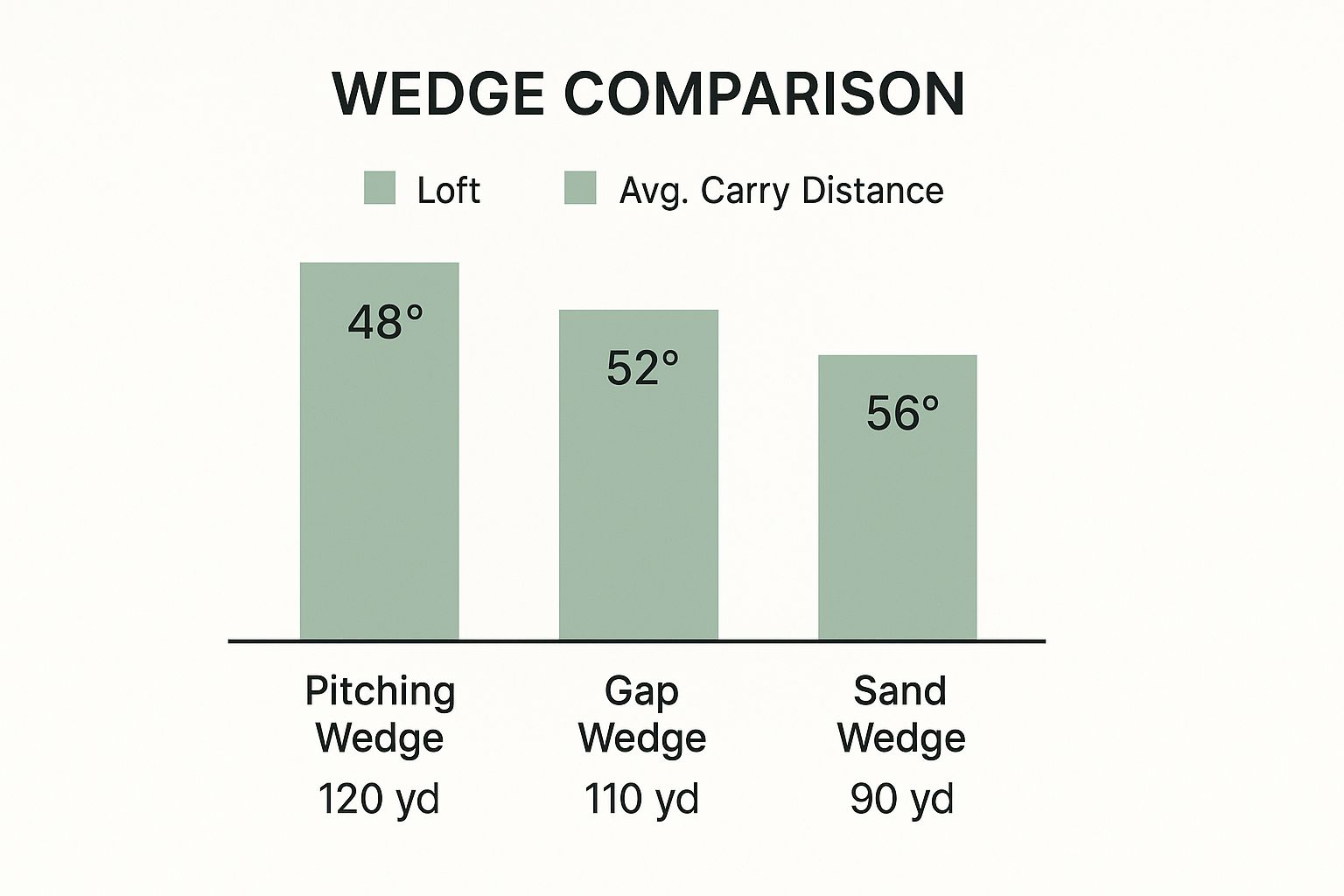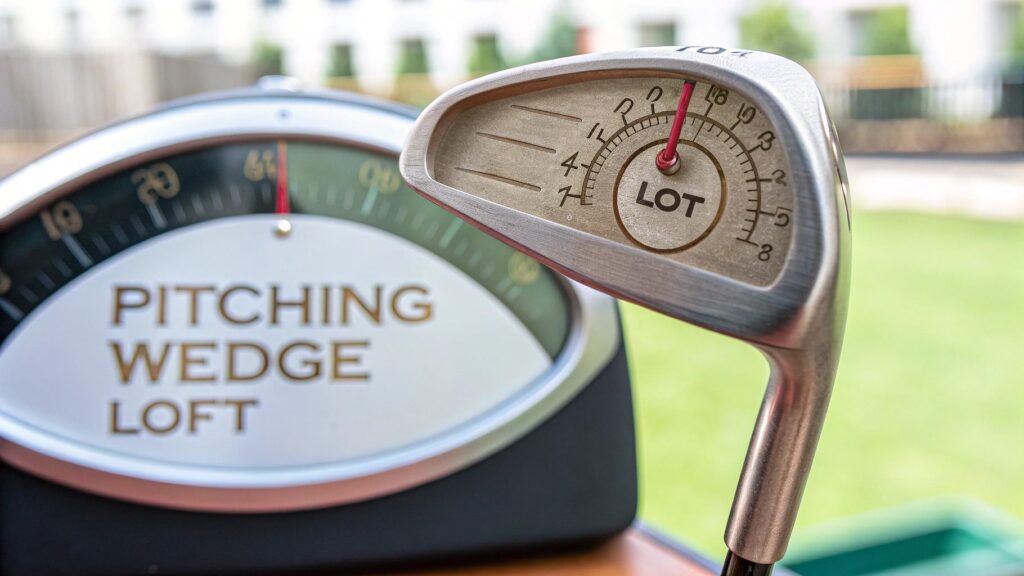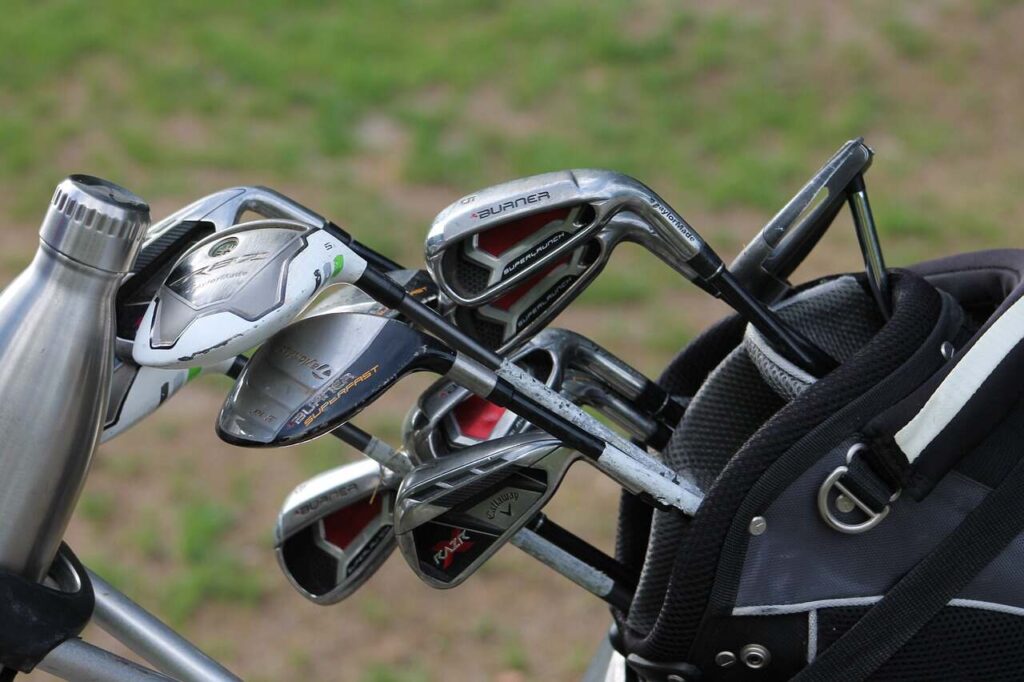Understanding what degree is a pitching wedge is crucial for mastering your short game. Let’s cut to the chase: there’s no single, universal degree for a pitching wedge. The days of a one-size-fits-all answer are long gone.
Today, you’ll find most pitching wedges have lofts somewhere between 43 and 48 degrees. This range has stretched over the years thanks to modern club design, which makes it absolutely essential for you to know your number if you want to dial in your short game.
What Degree Is a Pitching Wedge and Why It Matters
Why Your Pitching Wedge Loft Matters
Think of your pitching wedge as the captain of your short-game team. Its specific loft sets the baseline for every other scoring club in your bag. It dictates how far the ball flies, how high it launches, and, crucially, how quickly it stops once it hits the green.
So, why the huge variation? In a word: distance. Club manufacturers are in a constant race to help everyday golfers hit the ball farther. To do this, they strengthen the lofts of their irons. This trend has completely reshaped modern iron sets. Not too long ago—we’re talking pre-1990s—a pitching wedge was almost always 48 degrees. Now, it’s far more common to see them between 44 and 46 degrees to keep the distance gaps even with the stronger irons that come before it.
This “loft creep” makes knowing your exact number more important than ever. Just a few degrees can create a massive 10-15 yard gap in your setup, leaving you with those awkward yardages you just can’t seem to cover.
Your pitching wedge is the foundation of your entire short game. Playing with an unknown loft is like building a house without a blueprint—the results will be unpredictable and wildly inconsistent.
Understanding your pitching wedge is the first step toward building a reliable wedge system. Before you even think about what other wedges you need, you have to get a handle on the basic roles of the different types of golf clubs available.
Once you know your pitching wedge loft, you can make smarter choices about which gap, sand, and lob wedges will complete your set, ensuring you have the right club for every critical scoring distance inside 120 yards.
Typical Pitching Wedge Loft by Golf Iron Set Type
Not all pitching wedges are created equal. The loft of your wedge is heavily influenced by the type of iron set you play. Here’s a quick guide to what you can generally expect.
| Iron Set Type | Common Loft Range (Degrees) | Primary Design Goal |
|---|---|---|
| Game-Improvement | 43-45 | Maximize distance and forgiveness |
| Players Distance | 44-46 | A blend of distance, feel, and control |
| Players/Blades | 46-48 | Precision, feel, and workability |
As you can see, the stronger lofts in game-improvement sets are designed to help golfers who need a bit more distance. On the other hand, the weaker lofts in players’ irons offer the control and spin that skilled shot-makers crave. Knowing where your set falls helps you anticipate your wedge’s loft and build the rest of your bag accordingly.
Why Your Golf Pitching Wedge Loft Is a Moving Target
Ever hit a brand-new 7-iron and swear it flies as far as your old 5-iron? You’re not going crazy. The same thing is happening to your pitching wedge, all thanks to a long-running industry trend known as loft creep.
Think of it as “vanity sizing” for your golf clubs. To make their equipment more appealing, manufacturers strengthen club lofts—which just means decreasing the angle of the clubface—to help you hit the ball farther. Because let’s be honest, distance sells.
What used to be a standard 48-degree pitching wedge is now frequently 45 degrees, and sometimes even stronger.
This change doesn’t happen in a vacuum. It creates a domino effect across your entire set. To keep the yardage gaps between clubs consistent, if a manufacturer strengthens the 9-iron, they have to strengthen the pitching wedge right behind it.
The Marketing Behind the Numbers
The main driver behind loft creep is simple: marketing. When a weekend golfer goes for a club fitting and sees a new 8-iron flying 10 yards farther than their current one, it’s a powerful incentive to open their wallet.
But that “extra distance” is mostly a numbers game. That shiny new 8-iron might just have the same loft as your old 7-iron. It’s a marketing-driven trend that has completely changed what we should expect from our clubs.
The term “pitching wedge” no longer refers to a specific loft. It’s a moving target, defined more by a manufacturer’s quest for distance than by tradition.
This is exactly why you have to ignore the “PW” stamped on the bottom of your club and focus on the actual loft instead. Knowing your pitching wedge is 44 degrees is infinitely more useful than just knowing it’s a pitching wedge.
That single number is your key to building a reliable short game. It’s the starting point for picking your other wedges, like a gap or sand wedge, so you can eliminate those frustrating yardage gaps and start shooting lower scores.
How Loft Shapes Your Wedge Shots and Performance in Golf

That little number stamped on the sole of your pitching wedge? It’s much more than just a number. It’s the DNA of your shot, controlling everything from trajectory and spin to the final distance the ball travels. We call this loft, and understanding it is the secret to knowing how the ball will behave before you even swing.
Imagine a stronger-lofted pitching wedge, say a 43-degree model. This club is designed to produce a lower, more piercing ball flight. It’s perfect for punching through the wind or when you want the ball to release and roll out on the green. It gets in the air, but it travels on a rope with plenty of forward momentum.
Now, picture a weaker-lofted wedge, something around 48 degrees. This club is all about altitude. The steeper angle creates a much higher trajectory and a ton of backspin, which means the ball will land softly and stop almost immediately. This is your go-to when you’re firing at a tight pin and can’t afford any rollout.
From Loft to Launch in Golf
The relationship is pure cause-and-effect. Even a couple of degrees can completely change the type of shot you’re able to hit.
- Lower Loft (43-45°): This produces a lower launch and less spin, leading to a shot that runs out more after it lands. It’s a fantastic option for full shots from the fairway when you need to maximize distance.
- Higher Loft (46-48°): You’ll see a higher launch and more spin, resulting in a soft-landing shot that stops on a dime. This is exactly what you want for precision approaches to tucked pins.
Your pitching wedge’s loft has a direct impact on your gapping and how you plan shots around the green. Most golfers can expect their pitching wedge to carry anywhere from 90 to 120 yards, but this all comes down to the club’s specific loft and your swing. The modern standard tends to be around 45 to 47 degrees, though this can vary. For a deeper dive, you can find more great info on wedge lofts on Golfbit.com.
When you truly understand how your wedge’s loft translates to real-world results, you can start visualizing and executing the exact shot you need. Suddenly, that pitching wedge isn’t just another club—it’s your most versatile scoring tool.
Build Your Perfect Golf Wedge Setup with Proper Gapping
Knowing the exact loft of your pitching wedge is the key to unlocking a killer short game. Think of it as the foundation of your scoring arsenal. That number is the starting point for a crucial concept called wedge gapping—the art of building a set of wedges that leaves no awkward distances inside 120 yards.
The goal is to create predictable, consistent yardage gaps between each wedge, usually around 10-15 yards. Without a proper system, you’ll constantly find yourself in no-man’s land. You know the shot: 80 yards out, where a full pitching wedge is too much club, but a soft sand wedge just won’t get there. Those “in-between” shots are where strokes pile up.
By building your wedge set logically, you can eliminate those head-scratching moments for good. It all starts with your pitching wedge.
Golf Wedge: The 4-to-6 Degree Rule
A simple, tour-proven method for creating consistent yardage gaps is to maintain a 4 to 6-degree loft gap between each of your wedges. It’s a straightforward rule that just works. For example, if your pitching wedge is a modern 44-degree club, your next wedge—the gap wedge—should be right around 48 to 50 degrees. This methodical approach ensures you have the right tool for every job.
A well-gapped wedge set turns guesswork into a system. Instead of hoping you can take ‘a little off’ a full swing, you’ll have a specific club designed for that exact distance. That breeds confidence over the ball.
The image below gives a great visual of how these loft differences translate directly to carry distances for a typical amateur player.

As you can see, those 4-degree increases in loft create nice, even 10-20 yard gaps between clubs. That’s the kind of predictable distance control that helps you attack pins instead of just hoping to get it on the green.
To give you a better idea of how this works in practice, here’s a table showing how you can build out a set based on common pitching wedge lofts.
Sample Wedge Gapping Based on Pitching Wedge Loft
| Pitching Wedge (PW) | Recommended Gap Wedge (GW) | Recommended Sand Wedge (SW) | Recommended Lob Wedge (LW) |
|---|---|---|---|
| 44° | 48° – 50° | 54° – 56° | 58° – 60° |
| 45° | 50° | 54° – 56° | 58° – 60° |
| 46° | 50° – 52° | 56° | 60° |
This table shows how easily you can map out your ideal wedge lofts by starting with your PW and applying the 4-to-6 degree rule.
Following this logic, you can build a complete and reliable system from your strongest wedge down to your most lofted one. The most common wedge progression for golfers is:
- Pitching Wedge (PW): The starting point, usually included with your iron set.
- Gap Wedge (GW/AW): Fills the “gap” in distance between the PW and SW.
- Sand Wedge (SW): Your go-to for bunker shots, but also a versatile weapon from the fairway.
- Lob Wedge (LW): The highest-lofted club in the bag, used for delicate, high-arcing shots around the green.
By paying attention to your pitching wedge’s loft and the gaps that follow, you can build a setup that covers every distance and helps you knock it close with confidence.
How to Find the True Loft of Your Pitching Wedge in Golf

Okay, so you understand why knowing your pitching wedge loft is so important. But how do you actually find that magic number? It’s easier than you might think, and there are a few simple ways to figure out your club’s real specs.
Getting that exact number is the first step toward true distance control. Your pitching wedge loft isn’t just some random number; it’s the cornerstone of your entire short-game strategy. When lofts are mismatched, you end up with frustrating and unpredictable distance gaps, which are absolute score-killers around the green. You can learn more about the impact of wedge lofts on MyGolfSpy.
Your Guide to Finding the Loft in Golf
Ready to track down that number? Here are three practical ways to uncover your pitching wedge’s true loft.
- Check the Manufacturer’s Website: This is the quickest and easiest place to start. A simple search for your iron model on the manufacturer’s site (like Titleist, Callaway, or TaylorMade) should bring up a spec sheet with the exact loft.
- Look at the Clubhead: Some club makers make it even easier by stamping the loft right on the club itself. Check the hosel (where the shaft connects to the head) or the sole of your wedge for a number like “45” or “46.”
- Visit a Club Fitter: This is, by far, the most reliable method. A professional at a golf shop or fitting studio can put your wedge on a loft and lie machine for a precise measurement in seconds.
Getting your loft professionally checked is a smart move, because the angle can actually change over time. Hitting shot after shot off firm turf or range mats can slowly bend the hosel, altering the loft by a degree or two without you even realizing it.
Ultimately, a professional measurement is the only way to be 100% certain your numbers are accurate. That certainty is what allows you to build a perfectly gapped wedge set that gives you confidence on every single approach shot.
FAQ’S
Alright, let’s tackle some of the most common questions golfers have about wedge lofts. Getting these sorted out is the key to taking what you’ve learned and actually applying it to your own bag. Think of this as the final tune-up for your short-game knowledge.
Is a 48-Degree Wedge a Pitching Wedge or a Gap Wedge?
This is a classic “it depends” situation, and it perfectly highlights why you can’t just go by the letter stamped on the club.
In a more traditional set of irons (think players’ clubs or blades), 48 degrees is a very standard loft for a pitching wedge. But in many modern game-improvement sets, where the pitching wedge might be a super-strong 43 degrees, a 48-degree club slides in perfectly as a gap wedge. The label on the sole means far less than its actual job in your setup.
Should I Get My Pitching Wedge Loft Adjusted?
Absolutely. If you consistently find yourself with an awkward yardage gap between your 9-iron and your pitching wedge, don’t just live with it. A good club fitter can easily bend the loft a degree or two stronger or weaker to fix the problem.
It’s a simple, inexpensive tweak, but it’s one of the most effective ways to dial in your distances and eliminate those frustrating “in-between” shots for good.
What Is the Main Difference Between a Pitching and Gap Wedge?
The short answer is loft, but that single number changes everything: distance, trajectory, and spin.
A gap wedge (sometimes called an approach or “A” wedge) was created to fill the yardage “gap” that opened up between strong pitching wedges and traditional sand wedges. It will typically have 4-6 degrees more loft than your pitching wedge, giving you a reliable full-swing option for those shorter approach shots where your PW is just too much club.
Knowing your gear is just as important as knowing your swing. When you understand your numbers, you can play with a clear strategy instead of guessing. That’s a huge part of shooting lower scores. For golfers ready to take that next step, it’s also worth learning what a golf handicap is and how it’s calculated.
How Far Should a Typical Golfer Hit a Pitching Wedge?
While it varies for every player, we can look at some solid benchmarks.
Most amateur male golfers will hit a full pitching wedge somewhere between 100 and 125 yards. For female amateurs, that range is usually closer to 70 to 100 yards. Remember, these are just general guidelines. Your personal distance comes down to your swing speed, how well you strike the ball, and of course, the actual loft of your specific club. A 44-degree wedge is always going to fly farther than a 48-degree one, all else being equal.
At Golf Inquirer, our goal is to help you enjoy the game more by understanding it better. Explore our guides and tips to elevate your performance on the green! Learn more at https://golfinquirer.com.



